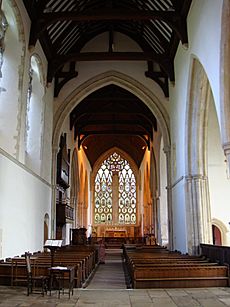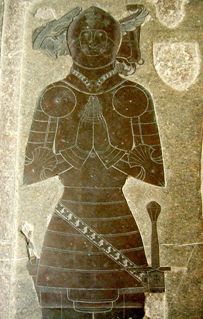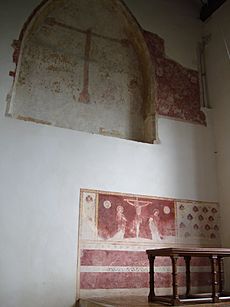Dorchester Abbey facts for kids
Quick facts for kids Dorchester Abbey |
|
|---|---|
| Abbey Church of St Peter & St Paul, Dorchester | |
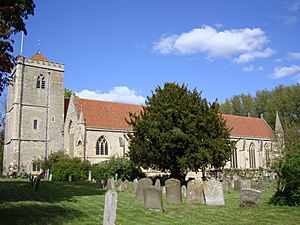
Dorchester Abbey viewed from the south
|
|
| Location | High Street, Dorchester on Thames, Oxfordshire OX10 7HH |
| Country | United Kingdom |
| Denomination | Church of England |
| Website | Dorchester Abbey |
| History | |
| Founded | 1140 |
| Founder(s) | Alexander, Bishop of Lincoln |
| Cult(s) present | Saint Birinus |
| Relics held | Shrine of Saint Birinus |
| Past bishop(s) | Saint Birinus |
| Administration | |
| Diocese | Oxford |
The Abbey Church of St Peter and St Paul, usually known as Dorchester Abbey, is a beautiful Church of England parish church in the village of Dorchester on Thames, Oxfordshire. It is located about 8 miles (13 km) southeast of the city of Oxford.
Long ago, this impressive building was a Norman abbey church. It was built on the same spot where an even older Saxon cathedral once stood. Today, it serves as the local church for the village community.
Contents
The Abbey's Long History
The story of Dorchester Abbey begins over 1,400 years ago. The town was once a Roman settlement and later became an important center for the Anglo-Saxon kingdom of Mercia.
A Cathedral for a Saint
In the year 634, a missionary named Birinus was sent from Rome by the Pope to teach Christianity to the people of the area. He became the first bishop, and Dorchester became the home of a large cathedral. For over 400 years, it was a major religious center. However, in 1085, the bishop's main church, or see, was moved to the city of Lincoln.
The Augustinian Abbey
Fifty-five years later, in 1140, a man named Alexander, Bishop of Lincoln, decided to build a new abbey on the site. He founded it for a group of Augustinian priests called Canons Regular. These canons were special because they wore white robes instead of the usual black ones.
The new abbey was named after Saints Peter and Paul, and also in honor of Saint Birinus. It was given a lot of land and money, making it quite wealthy.
A King's Big Changes
In the 1530s, King Henry VIII made huge changes to religion in England. He began to close down all the monasteries and abbeys in an event known as the Dissolution of the Monasteries.
In 1536, it was Dorchester Abbey's turn. The king's officials shut it down, and the special shrine to Saint Birinus was destroyed. The last abbot, John Mershe, was given a small pension to live on.
How the Church Was Saved
While many abbey buildings were torn down, the main church was saved. A local man named Richard Beauforest paid £140, a very large sum of money at the time, to buy the building from the king. In 1554, he gave the church to the people of Dorchester to use as their parish church. Thanks to him, the beautiful building still stands today. The church tower was later rebuilt in 1602.
Inside the Abbey Church
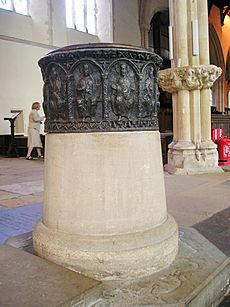
The church you see today was mostly built by the Augustinian canons. It is a very large church, measuring 230 feet (70 m) long and 55 feet (17 m) high. As you walk around, you can see different styles of architecture from different time periods.
- Norman Style: The north side of the church has features from the Norman period (around 1066-1200), known for its strong, rounded arches.
- Gothic Style: Most of the church was built in the Gothic style, which is famous for its pointed arches and large windows. The beautiful sanctuary, with its detailed carved stone seats and stunning stained-glass windows, was created around 1330. One of the most famous windows is the Jesse Tree window, which shows the family tree of Jesus in glass.
Special Treasures
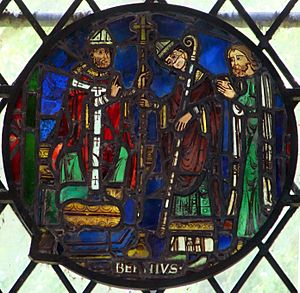
The abbey is home to many historic treasures:
- Leaden Font: It has a very rare baptismal font made of lead, which was used for baptisms hundreds of years ago.
- Wall Paintings: On the walls, you can see faint frescoes, which are paintings made on wet plaster, that date back to 1340.
- The "Swaggering Knight": One of the most famous tombs is an effigy (a stone sculpture of a person) of a knight. For a long time, people thought it was a knight named Sir John Holcombe. Now, historians believe it is more likely William de Valence the Younger, a nobleman who died in a battle in 1282.
Keeping the Abbey Beautiful
Starting in 1845, the abbey went through a long period of restoration to repair and preserve it. Several famous architects, including Sir George Gilbert Scott, worked on the project over 40 years.
More recently, in 1993, a special Union Jack flag was placed in the abbey. This flag had been used to cover the coffins of prisoners of war at a camp in Borneo during World War II.
Famous People Buried Here
Several important people from history are buried in the abbey.
- Saint Birinus, the first bishop of Dorchester.
- Sir John Drayton (died 1417), a local knight. You can see a brass rubbing of his tomb in the church.
- Wulfwig, a bishop from before the Norman Conquest.
- John Stonor, an important judge in the 1300s.
- Hugh Segrave, a treasurer for the King of England in the 14th century.
The Abbey Today
Today, Dorchester Abbey is more than just a historic building. It is an active parish church at the heart of its community. It is also used for concerts, festivals, and other cultural events.
Between 1998 and 2006, a huge fundraising effort raised £4 million to help preserve the abbey. This money was used to restore the old wall paintings and build a new visitor gallery and museum. The Dorchester Abbey Museum was even nominated for a major award in 2006.
The abbey is open for visitors every day from 8 a.m. until dusk.
See also
- List of English abbeys, priories and friaries serving as parish churches
- Bishop of Dorchester


